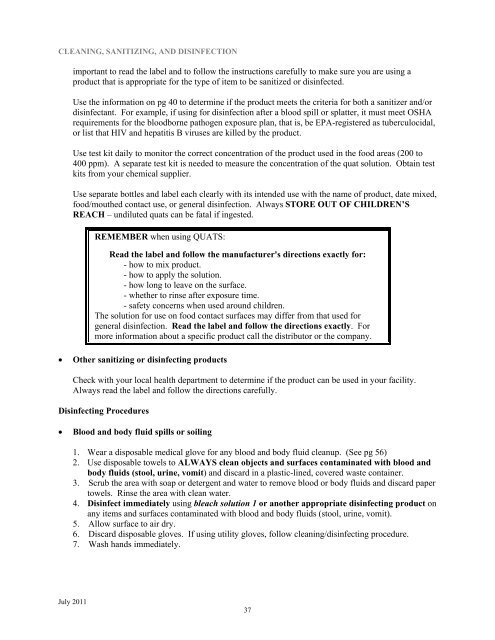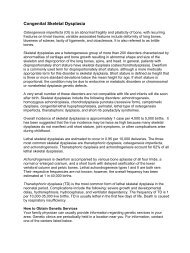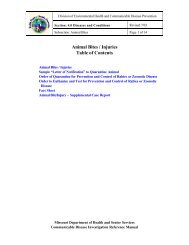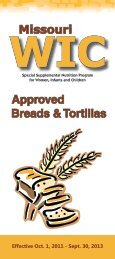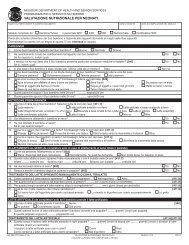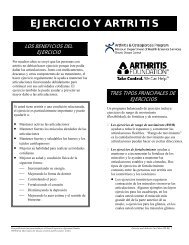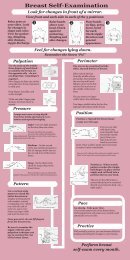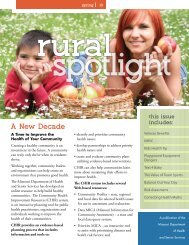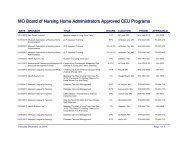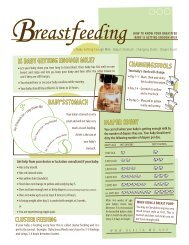Prevention and Control of Communicable Diseases - Missouri ...
Prevention and Control of Communicable Diseases - Missouri ...
Prevention and Control of Communicable Diseases - Missouri ...
You also want an ePaper? Increase the reach of your titles
YUMPU automatically turns print PDFs into web optimized ePapers that Google loves.
CLEANING, SANITIZING, AND DISINFECTION<br />
important to read the label <strong>and</strong> to follow the instructions carefully to make sure you are using a<br />
product that is appropriate for the type <strong>of</strong> item to be sanitized or disinfected.<br />
Use the information on pg 40 to determine if the product meets the criteria for both a sanitizer <strong>and</strong>/or<br />
disinfectant. For example, if using for disinfection after a blood spill or splatter, it must meet OSHA<br />
requirements for the bloodborne pathogen exposure plan, that is, be EPA-registered as tuberculocidal,<br />
or list that HIV <strong>and</strong> hepatitis B viruses are killed by the product.<br />
Use test kit daily to monitor the correct concentration <strong>of</strong> the product used in the food areas (200 to<br />
400 ppm). A separate test kit is needed to measure the concentration <strong>of</strong> the quat solution. Obtain test<br />
kits from your chemical supplier.<br />
Use separate bottles <strong>and</strong> label each clearly with its intended use with the name <strong>of</strong> product, date mixed,<br />
food/mouthed contact use, or general disinfection. Always STORE OUT OF CHILDREN’S<br />
REACH – undiluted quats can be fatal if ingested.<br />
July 2011<br />
REMEMBER when using QUATS:<br />
Read the label <strong>and</strong> follow the manufacturer's directions exactly for:<br />
- how to mix product.<br />
- how to apply the solution.<br />
- how long to leave on the surface.<br />
- whether to rinse after exposure time.<br />
- safety concerns when used around children.<br />
The solution for use on food contact surfaces may differ from that used for<br />
general disinfection. Read the label <strong>and</strong> follow the directions exactly. For<br />
more information about a specific product call the distributor or the company.<br />
� Other sanitizing or disinfecting products<br />
Check with your local health department to determine if the product can be used in your facility.<br />
Always read the label <strong>and</strong> follow the directions carefully.<br />
Disinfecting Procedures<br />
� Blood <strong>and</strong> body fluid spills or soiling<br />
1. Wear a disposable medical glove for any blood <strong>and</strong> body fluid cleanup. (See pg 56)<br />
2. Use disposable towels to ALWAYS clean objects <strong>and</strong> surfaces contaminated with blood <strong>and</strong><br />
body fluids (stool, urine, vomit) <strong>and</strong> discard in a plastic-lined, covered waste container.<br />
3. Scrub the area with soap or detergent <strong>and</strong> water to remove blood or body fluids <strong>and</strong> discard paper<br />
towels. Rinse the area with clean water.<br />
4. Disinfect immediately using bleach solution 1 or another appropriate disinfecting product on<br />
any items <strong>and</strong> surfaces contaminated with blood <strong>and</strong> body fluids (stool, urine, vomit).<br />
5. Allow surface to air dry.<br />
6. Discard disposable gloves. If using utility gloves, follow cleaning/disinfecting procedure.<br />
7. Wash h<strong>and</strong>s immediately.<br />
37


